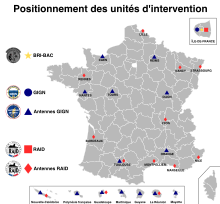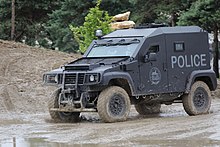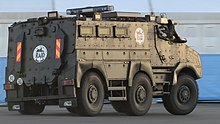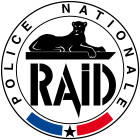|
RAID (French police unit)
Recherche, Assistance, Intervention, Dissuasion ("Search, Assistance, Intervention, Deterrence"), commonly abbreviated RAID (/reɪd/; French: [ʁɛd] ⓘ), is an elite tactical unit of the French National Police. Founded in 1985, it is headquartered in Bièvres, Essonne, approximately 20 kilometres (12 miles) southwest of Paris.[3] RAID is the National Police counterpart of the National Gendarmerie's GIGN. Both units share responsibility for the French territory.[note 1] Since 2009, RAID and the Paris Search and Intervention Brigade (BRI), a separate National Police unit reporting directly into the Paris Police Prefecture (French: Préfecture de police de Paris),[note 2] have formed a task force called National Police Intervention Force (French: Force d'intervention de la Police nationale) or FIPN. When activated, the task force is headed by the RAID commander. Thirteen regional units of the National Police, previously known as National Police Intervention Groups (GIPNs), have been created or permanently integrated into RAID and re-designated as "RAID branches" (French: antennes RAID) between 2015 and 2019.[note 3] Missions Among the main missions of RAID are:[4]
RAID reports to the director general of the National Police (DGPN), himself a direct report of the minister of the interior.
HistoryBefore the creation of RAID, the National Police did not have a national unit comparable to the Gendarmerie's GIGN and relied instead on regional units: BRI in Paris and the GIPNs in the provinces. Minister of the Interior Pierre Joxe was the key decision maker who authorized the creation of the unit.[5][note 4] RAID was founded by then-commissaires Robert Broussard and Ange Mancini in 1985. Broussard, one of the best known Police commissaires at the time, was one of the advisers who pushed the project. Mancini was chosen to be the unit's first commander.[5] RAID's first mission - a hostage situation in a Nantes tribunal, took place soon afterwards in December 1985.[6] In 1987 RAID arrested the leaders of the terrorist group Action Directe in their Vitry-aux-Loges hideout.[6] In May 1993, RAID solved a delicate hostage situation when a man named Erick Schmitt, calling himself "HB" (for "Human Bomb", in English), and carrying large quantities of explosives, took 21 hostages in a Neuilly-sur-Seine nursery school.[7] The hostage taker was finally shot and the children were recovered safely, together with their teacher and a nurse. In 1996, in Roubaix, the unit neutralized the Gang de Roubaix, a 14-member terrorist group tied to the Armed Islamic Group of Algeria (GIA), suspected of several bank robberies, murders, and a failed attack against the Group of Seven (G7) meeting in Lille. The assault was very violent and resulted in the death of four terrorists. Two RAID operatives were also injured, one by a grenade blast, the other hit by a bullet in a lung.[6] Christophe Caze, the head of the group, escaped the burning building, but was killed at a Belgian checkpoint during a gunfight with Customs agents. Several days later, thanks to an electronic device found on Caze's body, Fateh Kamel, head of a terrorist cell in Montreal, was arrested in Jordan and tried in France. RAID operators saw action during the 2005 and 2006 riots in France, as well as in a hostage situation in Versailles, where an armed man was shot dead by RAID operators after coming under attack. On 21 and 22 March 2012, RAID was tasked to arrest Mohammed Merah, the main suspect for shooting sprees in Toulouse and Montauban. RAID surrounded the flat where Merah was entrenched. After 30 hours of siege, RAID stormed the flat to apprehend Merah who fought back. After a four-minute shoot out, Merah was shot by a RAID sniper while exiting the building.[8] On 9 January 2015 RAID, together with BRI, a unit of the Paris Metropolitan Police, ended the hostage situation at the kosher supermarket Hypercacher on the third day of the January 2015 Paris terrorist attacks.[9] On 14 November 2015 RAID, again with the Paris BRI, took part in operations at the Bataclan theatre, where 90 people were killed during a series of bombings, shootings and hostage taking in Paris on 13 – 14 November. On 18 November RAID undertook a follow-up operation in Saint-Denis seeking Abdelhamid Abaaoud, the 'mastermind' of the attacks, who was killed.[10] RAID also provides close protection for foreign dignitaries traveling in France. During special events, RAID is also in charge of protecting French individuals abroad (For example, the French Delegation during the Olympic Games is under RAID protection during the whole event). Three RAID officers have been killed in action: two in Ris-Orangis (near Paris) in 1989 and one in Corsica in 1996.[11] Organisation RAID has a total strength of around 450 men and women, approx. 180 of which are in Bièvres, the rest in the regional branches located in Bordeaux, Guadeloupe, Lille, Lyon, Marseille, Montpellier, Nancy, New Caledonia, Nice, Rennes, Réunion, Strasbourg and Toulouse. The Bièvres (Paris) unit is divided into three main sections with about 60 members each:
The Negotiation group is on permanent alert. It deals with suicides, violent crises, mental disorders, hostage crises and other major troubles, independently from the rest of the RAID. It assesses the dangers of the situation, suggests possible solutions, and helps with the negotiations and the resolution of the crises. If the whole RAID has to intervene, the Negotiations section is used as a reconnaissance unit, and prepares the intervention of the other sections. To join the unit, an officer needs five years duty within the Police Nationale and after passing a thorough test he will serve in the RAID for five years. With a commendation he can expand it further five years. All members must leave the tactical unit after ten years. Candidates must be under forty to apply. Female officers are admitted in almost all positions. Helicopter support is provided by Sécurité Civile and the National Gendarmerie. Tactical deployment of large groups is handled by GIH (French: Groupe interarmées d'hélicoptères) a joint army/air force special operations flight equipped with SA330 PUMA helicopters based in nearby Villacoublay air base. GIH was established in 2006, initially to support GIGN. Its role has been expanded to also support RAID in 2008. Coordination between GIGN and RAID is handled by a joint organization called Ucofi (French: Unité de coordination des forces d’intervention). A "leader/follower" protocol has been established for use when both units need to be engaged jointly,[note 5] leadership belonging to the unit operating in its primary area of responsibility.[12] RAID is also a member of the European ATLAS Network, an informal association consisting of the special police units of the 28 states of the European Union. RAID Commanders
Specialties
EquipmentWeapons
Vehicles  See also
Notes
References
BibliographyThe following books and articles are in French. Books
Magazines
External linksWikimedia Commons has media related to Recherche Assistance Intervention Dissuasion.
|
||||||||||||||||||||||||||||||||||||



